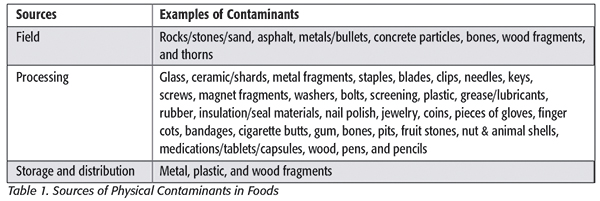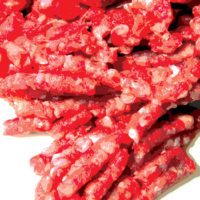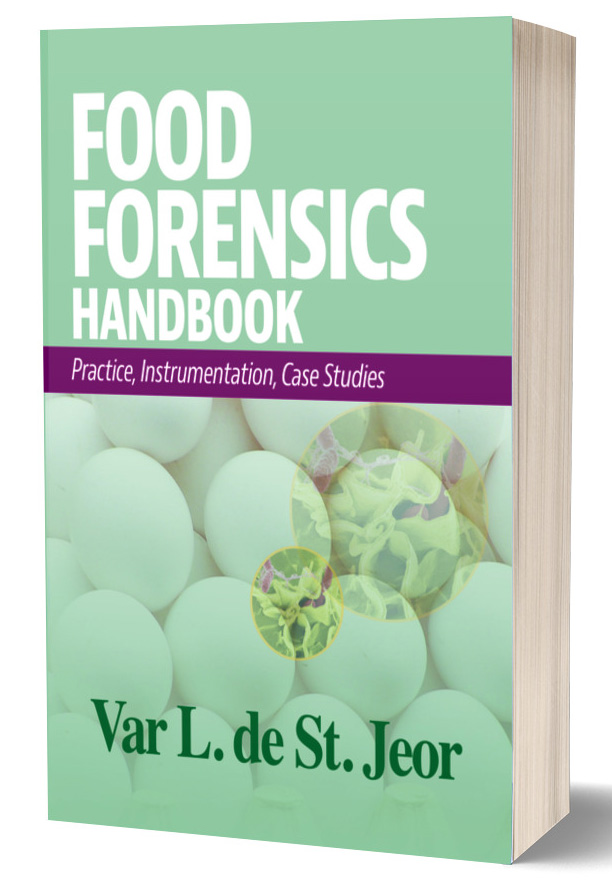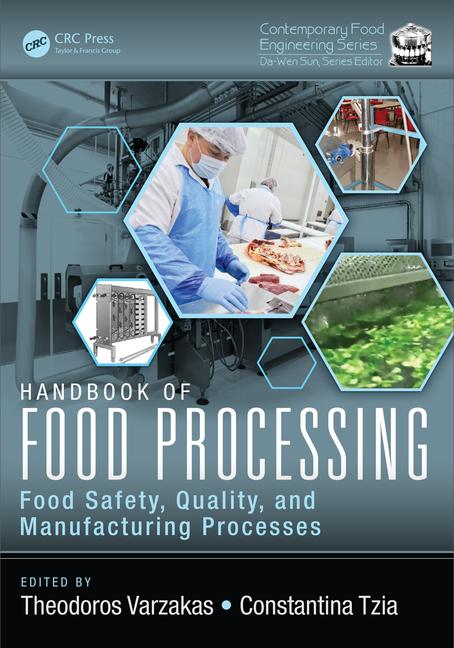Investigation and Identification of Physical Contaminants in Food

Americans spend about $500 billion on food annually.[1] When we consume food or drink, we expect to enjoy it and do not expect to get sick or injured. Ingestion of a piece of a hard or sharp material such as glass or metal could cause an unsuspecting consumer severe injury, require surgery, or have deadly consequences. Therefore, food contamination has always been a major concern of the U.S. government, the food industry, and consumers.
Most physical contaminants of foods, such as pieces of hard plastic or wood, can cause consumers immediate injury; this includes all types of foods, including beverages, bottled water, and nutritional and functional products. Any physical material in food that does not belong in the product may be classified as a physical contaminant.
Physical contaminants are also referred to as physical hazards or foreign matter. Shrew teeth in a crop product or a piece of wire in a meat product are examples. Glass pieces, metal fragments, bone chips, and pits may all cause serious harm when ingested. Common examples of bodily harm include lacerations of the lips, the inside of the mouth, teeth, gums, tongue, throat, esophagus, stomach, and intestine, and even choking. Children and seniors are at greater risk and have the highest incidence of such harm.
Government agencies, food producers, manufacturers, distributors, and retailers must all protect the health of the consumer as one of their most important objectives and responsibilities. If there is any evidence or reason to believe there are physical contaminants in a food product that may cause illness or injury to consumers, government agencies, including the U.S. Food and Drug Administration (FDA) and the U.S. Department of Agriculture (USDA) Food Safety and Inspection Service (FSIS), reject the food product from sale in the U.S. market or request food recalls.
Huge economic losses to businesses may occur when a physical hazard is discovered. There were 456 food recalls in the U.S. in 2017 and 764 food recalls in 2016, which were announced by FDA and FSIS. Of those, foreign matter caused 42 recalls in 2017 and 44 recalls in 2016.[2,3] According to FSIS,[4] 16.51 million pounds of food were withdrawn from the market following 56 food recalls because of extraneous materials from 2015 to 2017.
Causes of Physical Contamination
 Physical contaminants in food could come from either external sources, such as metal fragments, or internal sources, such as bone particles and pits. They can be introduced into food products accidentally during harvesting or at any point during processing due to poor procedural practices anywhere in the food chain, including manufacturing, storage, transportation, or retail. The so-called Dirty Dozen, the 12 most common foreign material contaminants in food, are glass, wood, stones, metal, jewelry, insects/filth, insulation, bone, plastic, personal effects, bullets/BB shot, and needles.[5] Table 1 provides a summary of common sources.
Physical contaminants in food could come from either external sources, such as metal fragments, or internal sources, such as bone particles and pits. They can be introduced into food products accidentally during harvesting or at any point during processing due to poor procedural practices anywhere in the food chain, including manufacturing, storage, transportation, or retail. The so-called Dirty Dozen, the 12 most common foreign material contaminants in food, are glass, wood, stones, metal, jewelry, insects/filth, insulation, bone, plastic, personal effects, bullets/BB shot, and needles.[5] Table 1 provides a summary of common sources.
Investigation and Identification of Physical Contaminants
Food companies work hard to keep their products free of contaminants. Investigation and control of physical contaminants in food should be conducted throughout the whole processing chain or in food testing laboratories. With accurate and timely information, a thorough investigation can be carried out in testing laboratories in a cost-effective and efficient manner. It is essential to have a professional investigation team with appropriate resources and equipment to help food company quality assurance staff troubleshoot consumer complaints and answer questions as to what the contaminants and their sources are. It is often necessary to apply integrated, multidimensional approaches for complicated investigations.
Comprehensive investigation can demand microscopy-based examinations plus chemical techniques, on-site examinations, Fourier transform-infrared (FTIR) analysis, and other techniques. The investigation processes and screening procedures depend on the particular physical contaminants and their sources. The procedures can be combined or modified methods found from the following: AOAC International, American Spice Trade Association, FDA’s Macroanalytical Procedures Manual, FDA’s Laboratory Information Bulletins, USDA’s foreign matter identification documents, the United States Pharmacopeia, and other compendious sources.
In general, special investigation procedures include:
• Inspect and target suspected sources of physical contaminants
• Identify the foreign matter
• Determine or evaluate the root cause or sources
These procedures consist of eight steps:
1. Target contaminants. In many cases, it is necessary to select a suitable investigational procedure, including sample inspection, preparation, and identification of target contaminants. The sources of contamination are diverse, whether individual or related, or even unknown. Often, little is known about the contaminants, how many there might be, what size, what their regulatory status might be, or whether they might be in a food mixture.
Preexamination steps allow judgments to be made as to whether the targets can be separated by size, shape, mass or magnetic properties, the type of samples and contaminants (e.g., organic or inorganic), amount, circumstances of contamination, and levels. It is normally required to conduct resampling, inspection, macroscopic examination, extraction, filtration, floating, sieving, burning, dyeing, and further examination using X-ray, metal detectors/magnets, and other screening or targeting technologies. An example might be to use magnets to gather and identify ferrous metal particles from liquid samples.
2. Identify contaminants. Once the suspected foreign matter screening procedures are carried out using stereo or dissecting microscopic examinations as a starting point, one can obtain detailed evidence, identifying the morphology and deciding what methods of analysis should be applied. For example, if a complainant believes that pieces of glass were observed by the naked eye in a food, it may be that the material consists of rocks, salt, sugar, plastics, minerals, struvite, or tartrate crystals. If needed, a compound microscope, bright-field/dark-field microscope, polarized microscope, or scanning electron microscope could be applied to reveal more details. Further tests are determined based on the results of microscopic examinations. Selection of such analytical strategies may require a combination of techniques or the development of multidisciplinary approaches, depending on contaminant conditions and the goals of the investigation.
3. Conduct physical property tests. A polarized microscope is used to display birefringent properties from some materials, such as synthetic polymers. Spectroscopic techniques can reveal specific functional groups of a chemical material. For example, different plastics may be identified by FTIR analysis. Physical properties can be classified by many characteristics and features, such as size, shape, thickness, magnetic characteristics, solubility, buoyancy, elasticity, flexibility, flammability, temperature resistance, etc.
4. Perform a chemical examination. Chemical analysis, including an elemental analysis, can reveal characteristic features that enable an understanding of chemical properties. Histochemical staining techniques are useful to test the chemical and physical properties of the contaminants. For instance, chemical reactions can be used for determination of lignin characteristics and enzymatic reactions.
5. Confirm. In many cases, no single method is 100 percent guaranteed to complete an investigation and identification. Further testing may be required to validate the findings or disprove them. For example, analysis by atomic absorption spectroscopy or other elemental analysis techniques reveals different types of metals. Examination of the combustion qualities of a sample can be used to find and quantitate foreign ferrous metal particles. Protein quantitative tests can confirm the presence of animal matter.
6. Compare. Building a reference library is necessary for a forensics laboratory. Identification relies on the availability of good reference library texts and official methods containing authentic reference materials as well as spectral databases to obtain definitive confirmation of the contaminants.
7. Evaluate the root cause. Whether a contaminant went through a specific processing step and was introduced into the product prior to or after packaging, potential sources could be uncovered through a prudent review of all test results and existing factors. If a piece of glass was confirmed, the following question will be raised: Is it more likely to be from a lightbulb, bottle, window glass, or drinking glass? This evaluation can be done to obtain more detailed information and evidence from the contaminant’s size, shape, mass, and characteristic features, especially compared with authentic reference materials. Any reference samples provided by clients are helpful to address the root cause.
8. Prepare a comprehensive report. After the investigation and identification are complete, a comprehensive report should be prepared, containing a summary of the project goals, sample information, test methods, imaging evidence, findings, evaluations, and/or suggestions.
Conclusions
A considerable variety of contaminants are possible in food that can render a food undesirable as a potential health hazard. Food companies rely heavily on a wide range of methods to minimize contamination and to detect it when it occurs. Investigation, identification, and remediation of food contaminants are powerful means to proactively avoid safety threats to consumer health and major losses to a company’s reputation and finances.
Food safety investigation and hazard prevention are complex and challenging. A strong, well-networked investigatory team is essential. A forensics team equipped with a wide range of knowledge, skills, and experience is crucial. These investigators must have good judgment when adverse incidents occur and be able to determine the precise characteristics and features of the physical contaminants. Because each incident varies, the capability to develop relevant techniques for a complex investigation is challenging and essential to the forensic laboratory.
Samuel S. Liu, Ph.D., is a science officer and chief entomologist in the food forensics department of Certified Laboratories Inc.
References
1. www.fsis.usda.gov/wps/wcm/connect/8018601c-12c2-47d8-93a4-9511558711f7/PHVT_New_Employee_Orientation.pdf?MOD=AJPERES.
2. www.food-safety.com/enewsletter/a-look-back-at-2017-food-recalls/.
3. www.food-safety.com/enewsletter/a-look-back-at-2016-food-recalls/.
4. www.fsis.usda.gov/wps/portal/fsis/topics/recalls-and-public-health-alerts/recall-summaries.
5. www.food-safety.com/magazine-archive1/aprilmay-2003/the-dirty-dozen-ways-to-reduce-the-12-biggest-foreign-materials-problems/.
Looking for a reprint of this article?
From high-res PDFs to custom plaques, order your copy today!
 Finding metal foreign objects in food is vital to food safety and quality. Inspection for such contaminants is usually located at the end of the line as the last line of defense before a product is on its way to the consumer. Yet, 1- to 2-frequency digital metal detectors, ubiquitous in food plants over the past 25+ years, have come with key barriers to achieving 100 percent metal-free products. Among the most difficult applications are dairy, meat, poultry, and bread.
Finding metal foreign objects in food is vital to food safety and quality. Inspection for such contaminants is usually located at the end of the line as the last line of defense before a product is on its way to the consumer. Yet, 1- to 2-frequency digital metal detectors, ubiquitous in food plants over the past 25+ years, have come with key barriers to achieving 100 percent metal-free products. Among the most difficult applications are dairy, meat, poultry, and bread.







